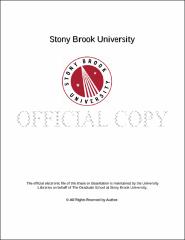| dc.identifier.uri | http://hdl.handle.net/11401/77127 | |
| dc.description.sponsorship | This work is sponsored by the Stony Brook University Graduate School in compliance with the requirements for completion of degree. | en_US |
| dc.format | Monograph | |
| dc.format.medium | Electronic Resource | en_US |
| dc.language.iso | en_US | |
| dc.publisher | The Graduate School, Stony Brook University: Stony Brook, NY. | |
| dc.type | Dissertation | |
| dcterms.abstract | The search for alternative fuels has increased over the past decade due to a growth in energy demand and the need to reduce carbon output. Hydrogen has been seen as a potential replacement for fossil fuels, such as oil and coal. A clean source of hydrogen and can be processed via the water gas (WGS) shift reaction (H<sub>2</sub>O + CO → CO<sub>2</sub> + H<sub>2</sub>). However, current industrial catalysts are comprised of a mixture of metal-oxides and supported nanoparticles that are often too complex to accurately elucidate reaction mechanisms. Using well defined " model systems" in a controlled reaction environment provides a route to gain fundamental understanding of how these catalysts function. Work presented here focuses on the study of model metal oxides and supported nanoparticles for the production of hydrogen. Primarily the WGS reaction has been investigated on Au/TiO2 (110), Cu/TiO<sub>2</sub> (110) and Cu/CeO<sub>2</sub>/YSZ (111) catalysts. These particular systems have been shown to be active for H<sub>2</sub> generation under simulated industrial conditions, but little is known about their thermal reactivity and stability. It was found that the function of oxide surfaces was to adsorb and dissociate water, while the nanoparticles are the main source of CO adsorption above 300 K. The role of the metal oxide support was studied using Cu/CeO<sub>2</sub>. It is apparent a stronger metal-support interaction exists for ceria supported copper compared to titania supported copper and gold, evidenced by partial encapsulation of copper by ceria at elevated temperatures. These characteristics may be crucial to improve functional understanding of the industrial catalysts. Another method to produce clean hydrogen is to photocatalytically split water (2H<sub>2</sub>O → 2H<sub>2</sub> + O<sub>2</sub>). A study of the electronic structure, using x-ray photoelectron spectroscopy (XPS), of several potential water splitting photocatalysts was undertaken. A family of lanthanum titanate (LaTiO<sub>3.5</sub>) crystal surfaces was studied. Understanding the electronic states of each system may lend insight into the nature of their activity. The interaction of water on the surface of these materials was also studied. Results show that water does not dissociatively adsorb on the surface, suggesting that H<sub>2</sub>O, not -OH is the active reactant for H<sub>2</sub> generation. Another promising water splitting photocatalyst, SrTiO<sub>3</sub>:Rh, was also studied using XPS and showed that the incorporation of Rh<super>4+</super> ions into the lattice, and not Rh0 particle formation on the surface, was the driving force for increased visible light absorbance and photocatalytic activity. This emphasizes the role catalyst preparation plays in both the performance and stability of a catalyst. | |
| dcterms.available | 2017-09-20T16:52:02Z | |
| dcterms.contributor | Hanson, David | en_US |
| dcterms.contributor | White, Michael G | en_US |
| dcterms.contributor | Sears, Trevor | en_US |
| dcterms.contributor | Stacchiola, Dario. | en_US |
| dcterms.creator | Lofaro, John Conrad | |
| dcterms.dateAccepted | 2017-09-20T16:52:02Z | |
| dcterms.dateSubmitted | 2017-09-20T16:52:02Z | |
| dcterms.description | Department of Chemistry. | en_US |
| dcterms.extent | 130 pg. | en_US |
| dcterms.format | Application/PDF | en_US |
| dcterms.format | Monograph | |
| dcterms.identifier | http://hdl.handle.net/11401/77127 | |
| dcterms.issued | 2013-12-01 | |
| dcterms.language | en_US | |
| dcterms.provenance | Made available in DSpace on 2017-09-20T16:52:02Z (GMT). No. of bitstreams: 1
Lofaro_grad.sunysb_0771E_11462.pdf: 2935810 bytes, checksum: ed8de79b9f5233938100a79456e06469 (MD5)
Previous issue date: 1 | en |
| dcterms.publisher | The Graduate School, Stony Brook University: Stony Brook, NY. | |
| dcterms.subject | Catalysis, Ceria, Hydrogen, Nanoparticles, Titania | |
| dcterms.subject | Chemistry | |
| dcterms.title | A Surface Science Study of Metal Oxides and Supported Nanoparticles for the Production of Clean Hydrogen | |
| dcterms.type | Dissertation | |

